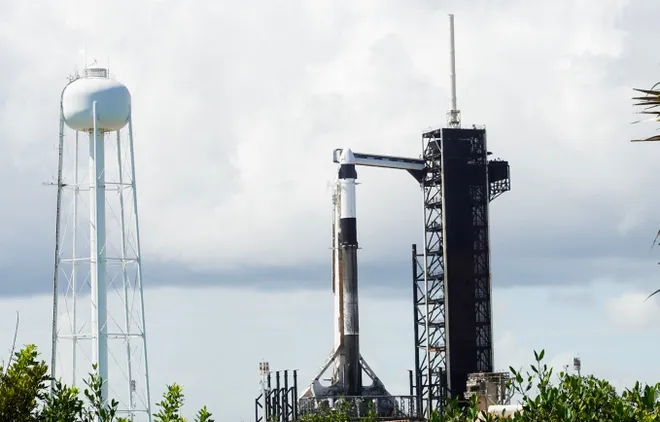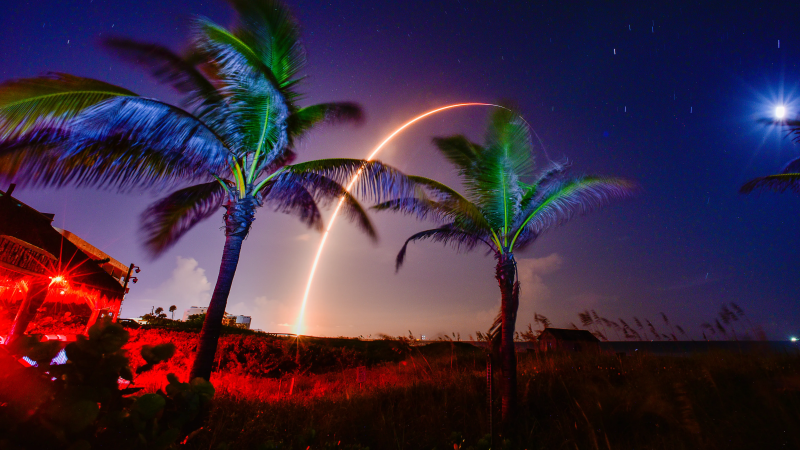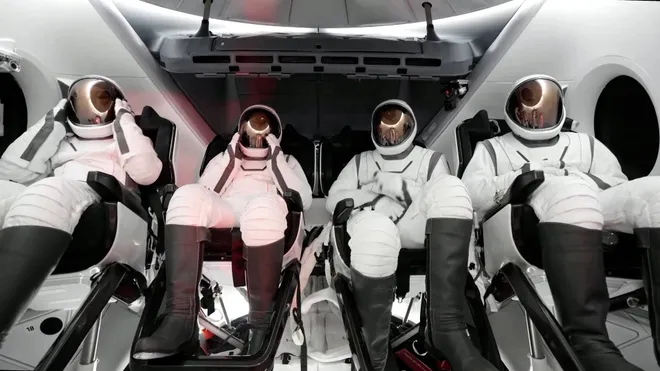Polaris Dawn: SpaceX targets new launch date for daring crewed mission
The Polaris Dawn mission could launch as early as Tuesday morning, sending its four-member crew of astronauts rocketing into orbit, where they will attempt the first-ever commercial spacewalk, SpaceX announced.
The pioneering private mission intended to put SpaceX technology to the test ahead of future deep-space missions has encountered a series of both technological and weather-related obstacles that have forced delay after delay. But now the Polaris Dawn crew might finally embark this week on the daring cosmic adventure after arriving three weeks ago at the Kennedy Space Center to make the final preparations for the long-awaited mission.
Led by billionaire entrepreneur Jared Isaacman, the crew is scheduled to journey higher than any human has reached in more than 50 years since the Apollo era and will attempt to become the first nongovernment astronauts to expose themselves to the vacuum of space. Isaacman, who was also behind another historic commercial mission in 2021 that marked the first all-civilian crew spaceflight, funded the expedition along with Elon Musk's SpaceX.
SpaceX confirmed the new targeted launch date Sunday night on social media site X.

How to watch Polaris Dawn launch
The Falcon 9 rocket that will carry the Polaris Dawn crew to orbit on a SpaceX Dragon capsule is targeting a 3:38 a.m. EDT launch Tuesday, SpaceX said.
The four-hour launch window also includes additional launch times at 5:23 a.m. and 7:09 a.m., the company said. If the launch doesn't take place Tuesday, SpaceX said another four-hour window is available Wednesday with the same launch times.
SpaceX will stream the launch on X, with the feed beginning about three-and-a-half hours before liftoff.
FLORIDA TODAY, part of the USA TODAY Network, will provide live coverage starting about two hours before liftoff at floridatoday.com/space.

Why has Polaris Dawn been delayed?
After three previous Polaris Dawn launch dates have been scrubbed, SpaceX has been waiting on a good weather forecast before scheduling another launch opportunity.
The Federal Aviation Administration also briefly grounded the company's Falcon 9 following an uncrewed landing mishap. Fortunately for SpaceX – and the Polaris Dawn crew – federal regulators cleared the rocket to resume launches within a couple days.
The first delay came when SpaceX moved the launch window back from Aug. 26 to Aug. 27 to give teams more time to complete preflight checks. By the time the launch date came, a helium leak on a piece a equipment designed to detach from the rocket during takeoff forced a second delay.
The third and most recent delay on Aug. 28 was on account of bad weather forecasted for the crew's return to Earth.
Mission needs good weather for launch and landing
As Isaacman explained on X, the mission requires a good weather forecast not only for launch, but for the crew's return five days later when they splash down off the coast of Florida.
Since Polaris Dawn is not docking with the International Space Station, the crew is entirely reliant on the resources they have in the Dragon and cannot delay a landing. That makes planning for a safe return during a set time period crucial.
The crew has remained in quarantine "staying productive, keeping fit, and ready to launch within approximately 30 hours of receiving a favorable forecast," Isaacman said on X.
"Space exploration demands patience, resilience, and teamwork," Isaacman said. "We are deeply grateful for the dedication of everyone involved and for the support of those who believe in our mission. Together, we are pushing the boundaries of what’s possible and continuing humanity’s journey to the stars."

What is the Polaris Dawn mission?
Polaris Dawn is the first of three human spaceflights under the Polaris Program, all of which are intended to test SpaceX technologies needed to carry humans deep into the cosmos.
Isaacman, founder of payments platform Shift4, previously flew to space as commander of Inspiration4. He will command a crew that includes pilot Scott “Kidd” Poteet and SpaceX engineers Sarah Gillis and Anna Menon, both of them mission specialists.
Menon will also read a children's book she co-authored for her own kids while in orbit.
The crew eventually plans to spend five days in orbit testing technology on behalf of SpaceX that could prove crucial as NASA and other space agencies set their sights on deep-space exploration, including destinations like Mars.

The launch itself should take the SpaceX Dragon capsule 870 miles above Earth – a trajectory that will take the crew through the treacherous inner regions of the planet's Van Allen radiation belts.
Once Polaris Dawn descends to a new cruising orbit at an altitude of about 435 miles, the crew will attempt to become the first nongovernment astronauts to do a spacewalk.
Because the Dragon does not have an airlock, the entire spacecraft will have to be depressurized when the hatch is opened, exposing the entire crew to the vacuum of space. All four astronauts will be wearing extravehicular activity (EVA) suits designed by SpaceX to receive oxygen through tethers, which they will test on behalf of the company.
The crew will also complete about 40 scientific experiments – many of which aim to understand the human body's reaction to long spaceflights – and test a new laser-based satellite communication system using Starlink.
Eric Lagatta covers breaking and trending news for USA TODAY. Reach him at elagatta@gannett.com
Disclaimer: The copyright of this article belongs to the original author. Reposting this article is solely for the purpose of information dissemination and does not constitute any investment advice. If there is any infringement, please contact us immediately. We will make corrections or deletions as necessary. Thank you.






